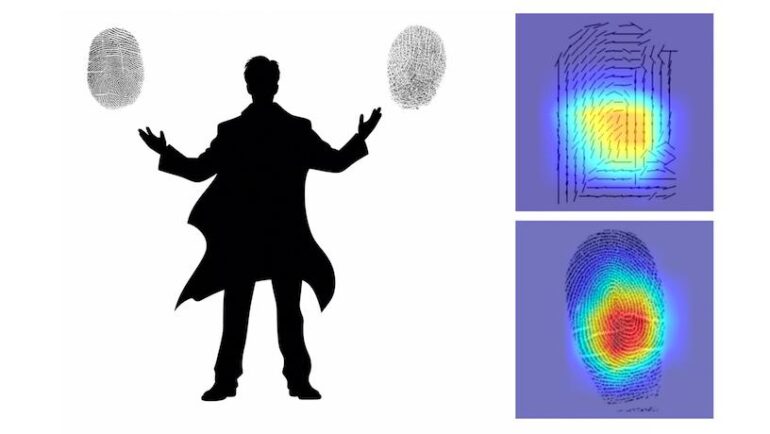TL;DR:
- Columbia engineers have developed an AI system that challenges the belief that every fingerprint is unique.
- Traditional forensic methods rely on fingerprint distinctiveness, but AI has shown that intra-person fingerprints share similarities.
- The AI achieved a 77% accuracy rate for matching fingerprints from different fingers and has the potential to significantly enhance forensic efficiency.
- Initial skepticism within the forensics community was met with persistence and further data refinement.
- The AI system’s unique approach focuses on angles and curvatures rather than traditional minutiae analysis.
- Broader datasets and rigorous validation are needed for practical use.
- This discovery highlights AI’s transformative potential in well-established fields and suggests an era of AI-led scientific discovery by non-experts.
Main AI News:
In the world of forensic science, fingerprints have long been regarded as the ultimate identifier, a unique imprint that could link individuals to crimes beyond a shadow of a doubt. However, a groundbreaking discovery by a team of Columbia engineers has upended this conventional wisdom, revealing that not every fingerprint is as distinctive as previously believed. In this exclusive report, we delve into how artificial intelligence (AI) has shattered the age-old myth, opening up new possibilities and challenges for the field of forensics.
Traditionally, forensic investigators have relied on fingerprints as the gold standard for connecting criminals to their misdeeds. Yet, when a perpetrator leaves fingerprints from different fingers at separate crime scenes, the task of linking them becomes exceedingly difficult, often resulting in cold cases. The widely accepted notion in the forensics community has been that fingerprints from different fingers of the same person, referred to as “intra-person fingerprints,” are unique and, therefore, impossible to match.
Enter Gabe Guo, a Columbia Engineering undergraduate senior with no prior knowledge of forensics. Guo and his team embarked on a groundbreaking research project that challenged this established belief. They harnessed the power of AI and fed a dataset of 60,000 fingerprints, paired in various combinations, into a deep contrastive network. Some pairs belonged to the same person but with different fingers, while others belonged to different individuals.
Over time, the AI system, which they tailored by modifying a state-of-the-art framework, developed the ability to discern when seemingly unique fingerprints belonged to the same individual and when they did not. Remarkably, the system achieved an accuracy rate of 77% for individual pairs, a figure that significantly escalated when multiple pairs were considered, potentially revolutionizing current forensic practices by increasing efficiency tenfold. This collaborative effort between Columbia Engineering’s Creative Machines lab and the University at Buffalo’s Embedded Sensors and Computing lab has been published in Science Advances.
However, their groundbreaking findings encountered initial skepticism within the forensics community. A well-established forensics journal rejected their research, citing the prevailing belief that every fingerprint is unique. Undeterred, the team continued to refine their AI system by gathering more data, ultimately achieving further improvement. Recognizing the significance of their discovery, they submitted their manuscript to a broader audience, leading to its acceptance for publication in Science Advances.
While the AI system’s accuracy may not yet be sufficient to definitively decide a case, it can undoubtedly assist in prioritizing leads in ambiguous situations. This development has the potential to breathe new life into cold cases and even prevent the wrongful conviction of innocent individuals.
What sets this AI apart is the revelation that it relies on a new kind of forensic marker, distinct from traditional minutiae analysis. Instead of examining the branchings and endpoints in fingerprint ridges, the AI focuses on the angles and curvatures of swirls and loops in the fingerprint’s center. This novel approach challenges the established methods and opens up exciting avenues for further research.
Columbia Engineering senior Aniv Ray and PhD student Judah Goldfeder, who assisted in data analysis, believe that the system’s performance will significantly improve as it is trained on a more extensive dataset, potentially comprising millions of fingerprints.
However, the team remains cognizant of potential biases in their data and emphasizes the need for comprehensive validation using datasets with broader coverage, particularly across genders and races.
Conclusion:
This groundbreaking AI-driven research challenges the long-standing assumption of fingerprint uniqueness. It has the potential to revolutionize the field of forensics, enabling more efficient criminal investigations and offering new avenues for research and development in fingerprint analysis technologies. Forensic science and technology companies should consider investing in AI-based solutions to stay at the forefront of this transformative shift in the industry.

